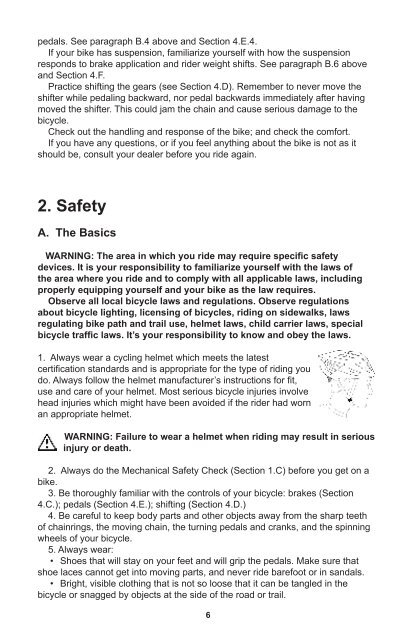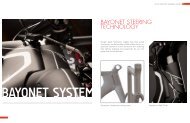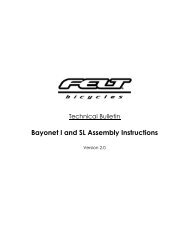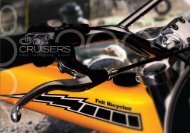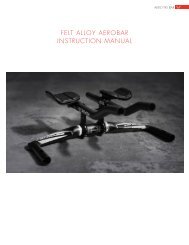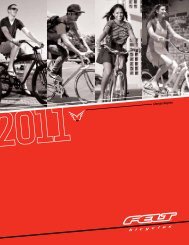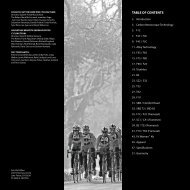Bicycle Owners Manual - Felt Bicycles
Bicycle Owners Manual - Felt Bicycles
Bicycle Owners Manual - Felt Bicycles
Create successful ePaper yourself
Turn your PDF publications into a flip-book with our unique Google optimized e-Paper software.
pedals. See paragraph B.4 above and Section 4.E.4.<br />
If your bike has suspension, familiarize yourself with how the suspension<br />
responds to brake application and rider weight shifts. See paragraph B.6 above<br />
and Section 4.F.<br />
Practice shifting the gears (see Section 4.D). Remember to never move the<br />
shifter while pedaling backward, nor pedal backwards immediately after having<br />
moved the shifter. This could jam the chain and cause serious damage to the<br />
bicycle.<br />
Check out the handling and response of the bike; and check the comfort.<br />
If you have any questions, or if you feel anything about the bike is not as it<br />
should be, consult your dealer before you ride again.<br />
2. Safety<br />
A. The Basics<br />
WARNING: The area in which you ride may require specific safety<br />
devices. It is your responsibility to familiarize yourself with the laws of<br />
the area where you ride and to comply with all applicable laws, including<br />
properly equipping yourself and your bike as the law requires.<br />
Observe all local bicycle laws and regulations. Observe regulations<br />
about bicycle lighting, licensing of bicycles, riding on sidewalks, laws<br />
regulating bike path and trail use, helmet laws, child carrier laws, special<br />
bicycle traffic laws. It’s your responsibility to know and obey the laws.<br />
1. Always wear a cycling helmet which meets the latest<br />
certification standards and is appropriate for the type of riding you<br />
do. Always follow the helmet manufacturer’s instructions for fit,<br />
use and care of your helmet. Most serious bicycle injuries involve<br />
head injuries which might have been avoided if the rider had worn<br />
an appropriate helmet.<br />
WARNING: Failure to wear a helmet when riding may result in serious<br />
injury or death.<br />
2. Always do the Mechanical Safety Check (Section 1.C) before you get on a<br />
bike.<br />
3. Be thoroughly familiar with the controls of your bicycle: brakes (Section<br />
4.C.); pedals (Section 4.E.); shifting (Section 4.D.)<br />
4. Be careful to keep body parts and other objects away from the sharp teeth<br />
of chainrings, the moving chain, the turning pedals and cranks, and the spinning<br />
wheels of your bicycle.<br />
5. Always wear:<br />
• Shoes that will stay on your feet and will grip the pedals. Make sure that<br />
shoe laces cannot get into moving parts, and never ride barefoot or in sandals.<br />
• Bright, visible clothing that is not so loose that it can be tangled in the<br />
bicycle or snagged by objects at the side of the road or trail.<br />
• Protective eyewear, to protect against airborne dirt, dust and bugs — tinted<br />
when the sun is bright, clear when it’s not.<br />
6. Don’t jump with your bike. Jumping a bike, particularly a BMX or mountain<br />
bike, can be fun; but it can put huge and unpredictable stress on the bicycle and<br />
its components. Riders who insist on jumping their bikes risk serious damage,<br />
to their bicycles as well as to themselves. Before you attempt to jump, do stunt<br />
riding or race with your bike, read and understand Section 2.F.<br />
7. Ride at a speed appropriate for conditions. Higher speed means higher risk.<br />
B. Riding Safety<br />
1. Obey all Rules of the Road and all local traffic laws.<br />
2. You are sharing the road or the path with others — motorists, pedestrians<br />
and other cyclists. Respect their rights.<br />
3. Ride defensively. Always assume that others do not see you.<br />
4. Look ahead, and be ready to avoid:<br />
• Vehicles slowing or turning, entering the road or your lane ahead of you, or<br />
coming up behind you.<br />
• Parked car doors opening.<br />
• Pedestrians stepping out.<br />
• Children or pets playing near the road.<br />
• Pot holes, sewer grating, railroad tracks, expansion joints, road or sidewalk<br />
construction, debris and other obstructions that could cause you to swerve into<br />
traffic, catch your wheel or cause you to have an accident.<br />
• The many other hazards and distractions which can occur on a bicycle ride.<br />
5. Ride in designated bike lanes, on designated bike paths or as close to the<br />
edge of the road as possible, in the direction of traffic flow or as directed by local<br />
governing laws.<br />
6. Stop at stop signs and traffic lights; slow down and look both ways at street<br />
intersections. Remember that a bicycle always loses in a collision with a motor<br />
vehicle, so be prepared to yield even if you have the right of way.<br />
7. Use approved hand signals for turning and stopping.<br />
8. Never ride with headphones. They mask traffic sounds and emergency<br />
vehicle sirens, distract you from concentrating on what’s going on around you,<br />
and their wires can tangle in the moving parts of the bicycle, causing you to lose<br />
control.<br />
9. Never carry a passenger, unless it is a small child wearing an approved<br />
helmet and secured in a correctly mounted child carrier or a child-carrying trailer.<br />
10. Never carry anything which obstructs your vision or your complete control<br />
of the bicycle, or which could become entangled in the moving parts of the<br />
bicycle.<br />
11. Never hitch a ride by holding on to another vehicle.<br />
12. Don’t do stunts, wheelies or jumps. If you intend to do stunts, wheelies,<br />
jumps or go racing with your bike despite our advice not to, read Section 2.F,<br />
Downhill, Stunt or Competition Biking, now. Think carefully about your skills<br />
before deciding to take the large risks that go with this kind of riding.<br />
13. Don’t weave through traffic or make any moves that may surprise people<br />
with whom you are sharing the road.<br />
14. Observe and yield the right of way.<br />
6 7


